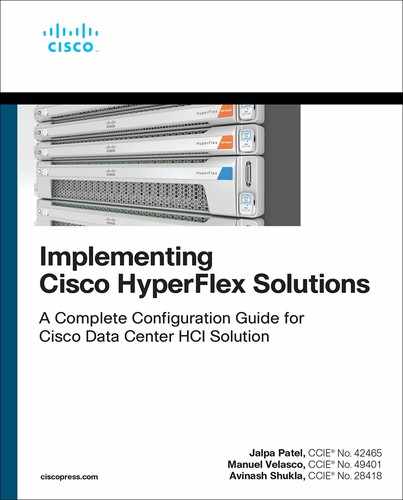Introduction
It is important to understand the various changes in data center technology and the evolution from traditional to converged and to hyperconverged infrastructure. As illustrated in Figure I-1, the traditional data center comprises the three layers of infrastructure—compute, storage, and networking (provided by individual companies as standalone layers)—where the customers are responsible for integrating these layers, basically building the complete infrastructure product themselves. Such environments are expensive to build and difficult to support, as there are a lot of different components (both hardware and software) involved. Maintaining traditional data centers involves many challenges, as upgrades, compatibility, and interoperability are time-consuming and complicated. Implementation can also be time-consuming and fraught with issues related to adding new resources in the existing environment.
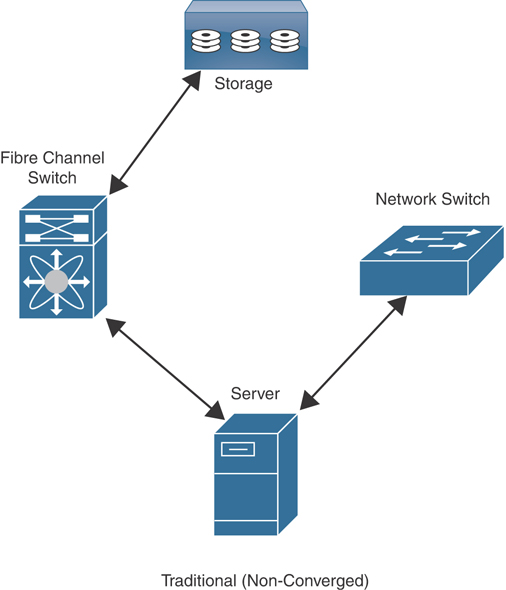
Figure I-1 Traditional (Non-Converged) Data Center
The next evolution of the data center was converged platforms (see Figure I-2), which brought advantages such as single-vendor support, faster deployment, and a validated building block approach. The converged architecture is an approach to data center management that packages compute, networking, storage, and virtualization tools together to simplify data center operations. The goal of converged infrastructure is to reduce complexity in data center management. The principal design factor is to eliminate issues of hardware incompatibility and provide ease of deployment and management to deliver multivendor-validated design and deliver predictable performance. Industry leaders such as Cisco, VMware, EMC, and NetApp came together to build partnerships (such as VCE and FlexPod) to deliver data center solutions predesigned and tested to reduce complexity for customers. This phase also saw a technological evolution in the form of unified fabric, with a lossless data center transport layer helping to enable the convergence of LANs and SANs onto a single unified fabric switch.

Figure I-2 Converged Data Center
The latest data center evolution is the hyperconverged infrastructure (HCI; see Figure I-3). HCI brings together the compute, memory, hypervisor, and storage devices of servers into a single platform for virtual servers. There is no longer a separate storage system, as the servers running the hypervisors also provide the software-defined storage resources to store the virtual servers, effectively storing the virtual machines on themselves. HCI removes nearly all the silos and is almost completely self-contained; it is also simpler to use, faster to deploy, and easier to consume than earlier evolutions, yet it is still flexible and offers high performance. Most hyperconverged systems rely on standard networking components, such as on-board network cards in the x86 servers and top-of-rack switches. Some key advantages of HCI are the simplification of deployment, easier day-to-day management operations, and increased agility, all of which reduce operational costs.

Figure I-3 Hyperconverged Infrastructure
Introduction to HCI
Hyperconverged infrastructure is a software-defined IT infrastructure that uses virtualized components of “hardware-defined” systems. Some of the important features of HCI are virtual computing, virtual storage, virtual networking, and a centralized management system (see Figure I-4).

Figure I-4 HCI Fundamentals
HCI solutions consist of the following fundamental components:
A tight integration of servers (x86) for compute, storage, networking, and virtualization in all-in-one appliances.
A simple automated deployment model that provides ease of use and reduces implementation time.
A central management system that allows easy administration of all HCI resources with an intuitive UI that helps eliminate separate management solutions for managing the infrastructure.
A storage solution that is a standard distributed file system spanning all nodes in a cluster to provide storage, networking, and virtualization capability to applications.
Ease of scalability and the ability to scale up or scale down one unit or appliance at a time.
Cisco’s HCI Solution: HyperFlex Overview
When you are looking to simplify your infrastructure, you really need a complete, enterprise-grade, hyperconverged platform that provides a foundation for your multi-cloud/hybrid cloud future and delivers the speed, simplicity, and scale necessary for your business to succeed today. You want a cloud-like experience within your own data center.
This is where HyperFlex bridges the industry gap. HyperFlex is the only complete HCI solution on the market, with compute, storage, and networking all integrated into a single solution provided by a single vendor. Most will agree that the network is the most critical component in a data center in our ability to connect to and effectively use public or other private cloud solutions. With HyperFlex, the entire stack—compute, HCI software, storage, and networking—are all provided by and supported by Cisco. This means better support for you and no vendor finger-pointing.
Cisco HyperFlex combines the convergence of computing and networking provided by Cisco UCS and next-generation hyperconverged storage software to uniquely provide the compute resources, network connectivity, storage, and hypervisor platform to run an entire virtual environment—all contained in a single uniform system. Figure I-5 shows Cisco Hyperflex evolution into a complete Hyperconverged solution.
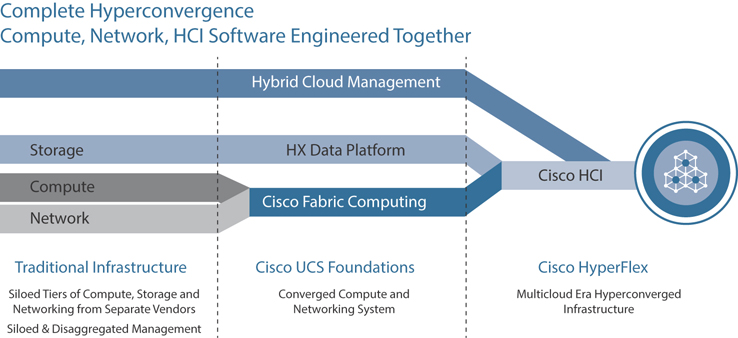
Figure I-5 Cisco HCI: HyperFlex
Cisco HyperFlex includes a purpose-built, high-performance, low-latency hyperconverged platform that adapts to support any application, in any cloud, anywhere (see Figure I-6). The platform supports multiple hypervisors and virtualized environments (including Microsoft Windows Server 2019 Hyper-V and VMware vSphere), Docker containers with Kubernetes, multi-cloud services, and edge deployments to efficiently and economically deploy, monitor, and manage applications. Cisco HyperFlex supports data center core, multi-cloud, and edge use cases.

Figure I-6 Cisco HCI: HyperFlex for the Data Center and the CloudOverview of HyperFlex Software Components
Cisco HyperFlex consists of the following main software components (see Figure I-7):
Storage controller
A storage controller is a virtual machine running Cisco HyperFlex Data Platform software with a dedicated number of processor cores and amount of memory, allowing it to deliver consistent performance without affecting the performance of the other virtual machines on the cluster.
The controller can access all storage without hypervisor intervention with the VMware VM_DIRECT_PATH feature.
It pools the local storage for distributed capacity. It uses the node’s memory and SSDs as part of a distributed caching layer and uses the node’s HDDs for a distributed-capacity storage.
Hypervisor integration
VIB (vSphere Installation Bundle) on the hypervisor (ESXi)
VAAI IO Visor (scvmclient)
stHypervisorSvc
vmware-esx-STFSNasPlugin
Hypervisor hosts presented with an NFS datastore
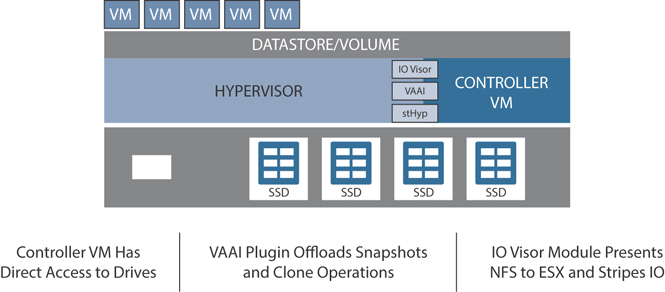
Figure I-7 HyperFlex Components
Deployment Options of Cisco HyperFlex
Cisco HyperFlex is an adaptive system that can power any application anywhere with the simplicity of hyperconvergence. It delivers flexibility to support multiple hypervisors, containerized environments, multi-cloud services, and edge deployment. Key deployment options of Cisco HyperFlex are as follows-
Available on hypervisors such as VMWare ESXi and Microsoft Hyper-V
HyperFlex container appliance
All application workloads, including VDI, VSI, databases, mission-critical workloads, and so on
Cloud-based management using Cisco Intersight
Types of HyperFlex deployment, including:
Edge deployments to remote offices and branch offices (ROBOs)
Standard clusters (up to 64 nodes)
Stretch clusters
Figure 1-8 covers the deployment options of Cisco HyperFlex

Figure I-8 HyperFlex Deployment Options
Figure 1-8, covers the deployment options of Cisco HyperFlex
Cisco HyperFlex Advantages
Cisco HyperFlex offers a number of advantages compared to other HCI solutions. The following are some of the most important of these advantages, although this is not an exhaustive list:
Single point of management and connectivity: Cisco HyperFlex is engineered on the industry-recognized Cisco UCS. Cisco UCS, the foundation for Cisco HyperFlex systems, is built with a single point of management and connectivity for the entire system. The system is designed as a single virtual blade server chassis that can span multiple chassis and racks of blade-and-rack server-based nodes. Cisco is in the unique position of being able to deliver a hyperconverged solution that can incorporate blade and rack systems in its architecture, offering greater flexibility than any other solution (see Figure I-9).
Scalability: Cisco HyperFlex provides the ability to scale seamlessly and easily (see Figure I-10). HyperFlex clusters can scale to up to 64 nodes, with protection against multiple node and component failures. HyperFlex can also scale across clouds and across data center locations.
Also, an already deployed HyperFlex cluster is easy to scale up or scale down. For example, you can start with as few as three nodes and add more nodes to the cluster with ease. You can also scale down and remove a node if required. Figures I-11 through I-14 demonstrate this ease of scaling.
Adaptability: Cisco HyperFlex is built on an adaptive infrastructure that supports external storage, ease of connectivity to legacy setups, and easy data transfer and VM migrations. Figure I-15 provides an overview of these advantages, including the ability to use existing UCS FI and support for external storage, which enables easier migration and data transfer.

Figure I-9 HyperFlex on UCS
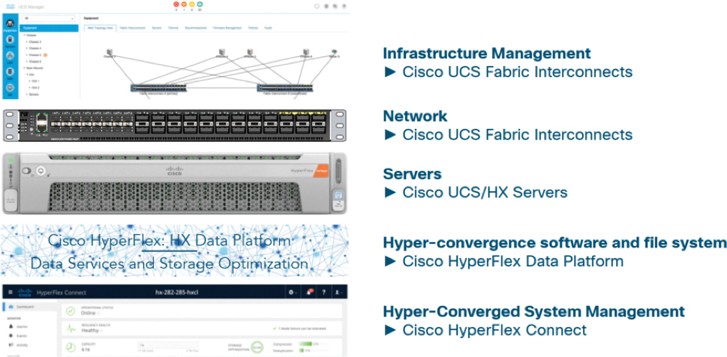
Figure I-10 HyperFlex’s Easy Scaling

Figure I-11 Starting with the Minimum Number of Nodes

Figure I-12 Adding More Nodes
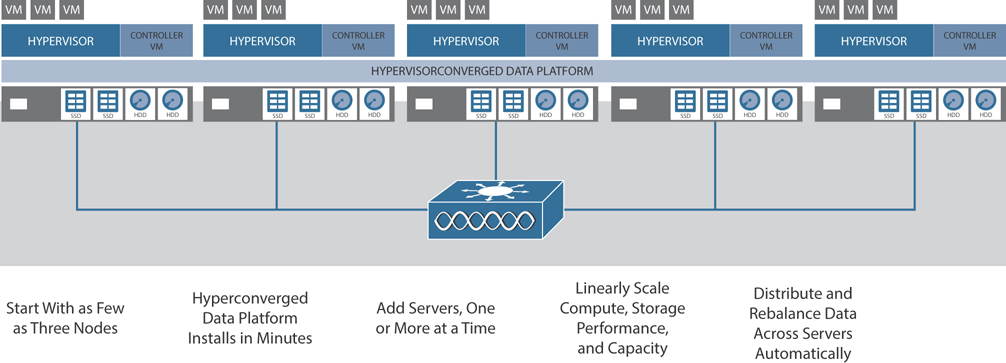
Figure I-13 Scaling Compute and Storage as Needed
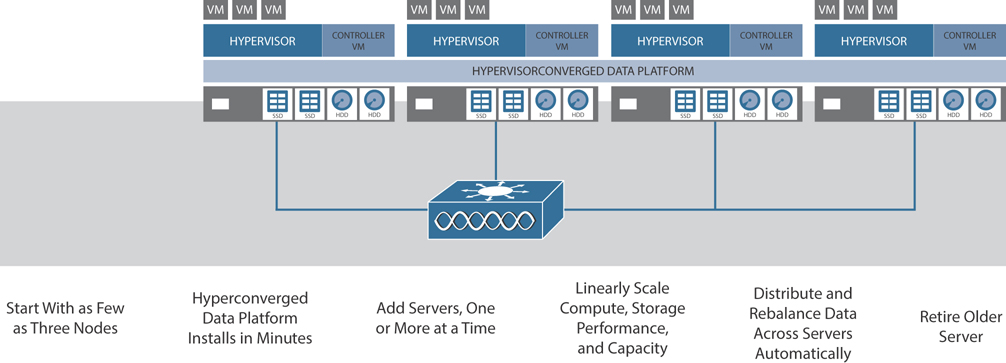
Figure I-14 Scaling Down/Retiring Servers
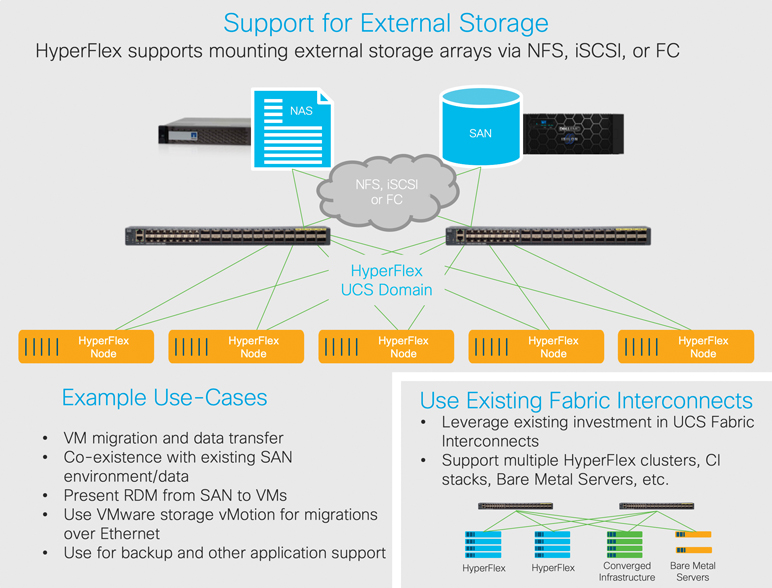
Figure I-15 Adaptive Infrastructure
Next generation management supported by Cisco Intersight: Cisco Intersight is a cloud-based management platform that provides end-to-end life cycle management and lets you install, configure, manage, and monitor HyperFlex from anywhere (see Figure I-16). Intersight also provides access to advanced features such as a recommendation engine and compatibility checker.
Replication and stretch clusters: The HyperFlex Data Platform disaster recovery feature allows you to protect virtual machines from disaster by setting up replication of running VMs between a pair of network-connected clusters. In addition, HyperFlex stretch clusters enable you to deploy an active/active disaster-avoidance solution for mission-critical workloads requiring high uptime (near zero recovery time objective) and no data loss (zero recovery point objective). See Figure I-17.

Figure I-16 Next-Gen Management
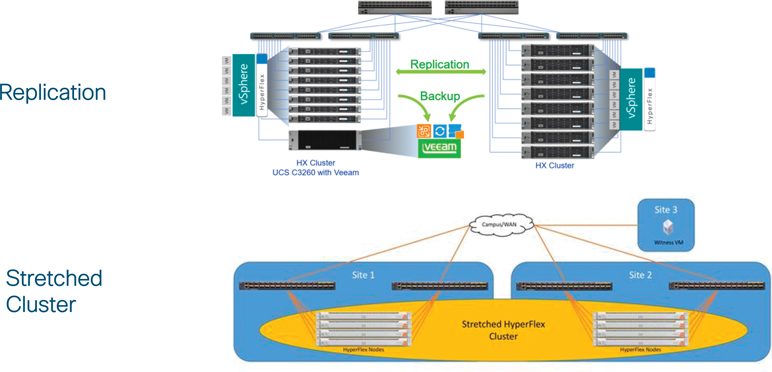
Figure I-17 Replication and Stretched Cluster
This book discusses each of these advantages in detail and describes how to leverage the features of HyperFlex to remove complexities and operate a complete data center using a HyperFlex solution. It also covers HyperFlex architecture, implementation, configuration, operations, and management.
